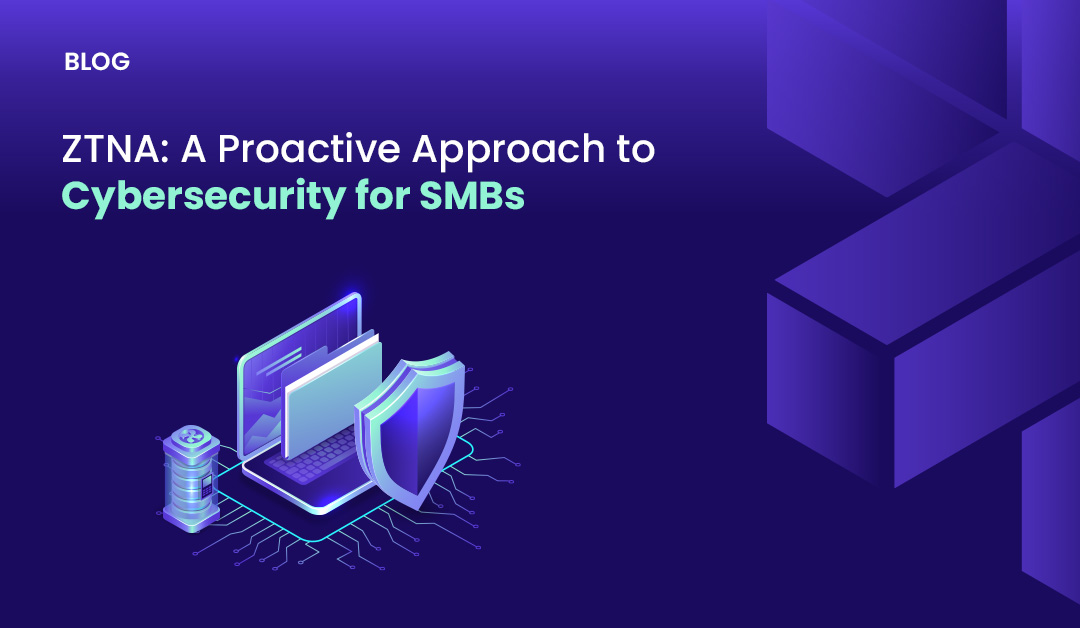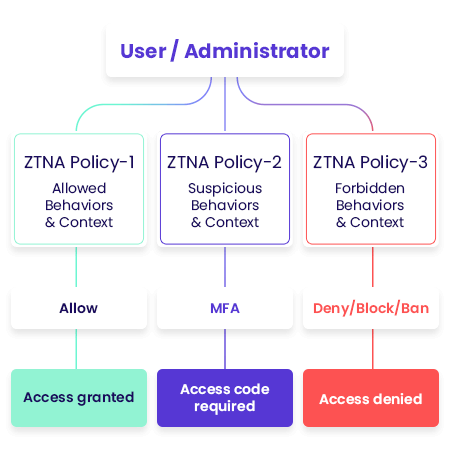ZTNA: A Proactive Approach to Cybersecurity for SMBs
As the digital landscape continues to evolve, small and medium-sized businesses (SMBs) are constantly faced with new cybersecurity threats. With the increasing prevalence of cyberattacks, it’s more crucial than ever for SMBs to take proactive measures to protect their data and digital assets. One such measure is the implementation of Zero Trust Network Access (ZTNA), […]
Author
Date
Category
All Categories
- AI-powered security
- Attacks & Threats
- Cybersecurity
- Hybrid Cloud
- Network
- Network Firewall
- Network Protection
- News
- Remote Workforce
- Security
- Zero Trust
Contents
Popular Posts
Product
Join the Newsletter

As the digital landscape continues to evolve, small and medium-sized businesses (SMBs) are constantly faced with new cybersecurity threats. With the increasing prevalence of cyberattacks, it’s more crucial than ever for SMBs to take proactive measures to protect their data and digital assets. One such measure is the implementation of Zero Trust Network Access (ZTNA), a security model that requires all users and devices to be authenticated and authorized before accessing network resources.
Understanding the Cybersecurity Landscape for SMBs
Today, cyberattacks are a harsh reality that SMBs must grapple with. According to recent studies, nearly 50% of all cyber breaches impact businesses with fewer than 1,000 employees, and over 60% of SMBs were targeted by cyberattacks in recent years. As cybercriminals become more sophisticated in their hacking methods, SMBs are at heightened risk of falling victim to ransomware attacks, data breaches, and other malicious activities.
Why SMBs are Prime Targets for Cyberattacks
Contrary to popular belief, SMBs are not less likely to be targeted by cybercriminals than their larger counterparts. There are several reasons why SMBs are enticing targets for hackers:
- Limited Resources: SMBs often have less robust security measures in place compared to larger corporations, making them an easier target for cybercriminals.
- High Value-to-Effort Ratio: SMBs often possess valuable data that can be exploited for financial gain, while presenting a relatively low barrier to breach due to their lack of stringent security infrastructure.
- Reduced Awareness and Protection: Many SMBs lack the resources and expertise to implement comprehensive cybersecurity measures, leaving them vulnerable to sophisticated cyberattacks.
The Consequences of Cyberattacks on SMBs
The impact of cyberattacks on SMBs can be devastating. From operational disruptions and financial losses to reputational damage and loss of customer trust, the aftermath of a cyberattack can be enough to put an SMB out of business. In fact, up to 60% of SMBs are forced to close within six months of a cyberattack.
Implementing ZTNA: A Proactive Approach to Cybersecurity for SMBs
To bolster their cybersecurity defenses, SMBs should consider implementing a ZTNA model. ZTNA operates on the principle of “never trust, always verify,” which means that all users and devices must be authenticated and authorized before accessing network resources, regardless of their location or device. This approach minimizes the cyber risk posed by potentially compromised credentials and devices, and provides a robust defense against hackers.
How ZTNA Works
ZTNA provides secure, encrypted access to an organization’s network, applications, and resources. With ZTNA, access is granted based on the user’s identity, the context of their request, and the risk associated with their device and network. This means that even if a user’s password is leaked or stolen, hackers can’t gain access to the network without the additional authentication factors required by ZTNA.

Benefits of ZTNA for SMBs
Implementing a ZTNA model offers several benefits for SMBs:
- Enhanced Security: By requiring multiple factors of authentication, ZTNA reduces the risk of unauthorized access to network resources.
- Reduced Attack Surface: ZTNA limits the number of potential entry points for hackers, thereby reducing the attack surface.
- Improved Visibility and Control: ZTNA provides detailed visibility into who is accessing the network and what they’re doing, enabling SMBs to detect and respond to potential threats more quickly.
Addressing SMB Concerns Regarding ZTNA
Despite the evident advantages of Zero Trust Network Access (ZTNA), some small and medium-sized businesses (SMBs) may hesitate to embrace this security approach due to misconceptions regarding its complexity or cost. Let’s tackle these common concerns:
Complexity of ZTNA:
Implementing ZTNA does demand a certain level of technical proficiency. However, many Managed Service Providers (MSPs) offer ZTNA as a service, making it more attainable for SMBs with limited IT resources. These providers manage the intricacies of ZTNA implementation and operation, enabling SMBs to concentrate on their primary business activities.
Cost of ZTNA:
The expense of a ZTNA solution can vary based on the organization’s size and network complexity. Nevertheless, when weighing the cost of ZTNA against potential financial repercussions of a cyberattack, investing in ZTNA is viewed as a prudent preventive measure. Moreover, numerous MSPs provide scalable ZTNA solutions that align with an SMB’s financial constraints.
Perception of Redundancy:
Some may argue that a firewall and antivirus software render ZTNA unnecessary. However, while firewalls and antivirus software are crucial elements of a cybersecurity strategy, they alone are insufficient to safeguard against modern cyber threats. ZTNA augments security by ensuring that only authenticated and authorized users and devices gain network access.
Conclusion
In today’s digital landscape, implementing robust cybersecurity measures like ZTNA is not just a recommendation for SMBs – it’s a necessity. By adopting a proactive approach to cybersecurity and leveraging the power of ZTNA, SMBs can significantly reduce their risk of falling victim to cyberattacks and ensure the security of their data and digital assets.
Get Started with Timus
Zero Trust. Adaptive Cloud Firewall. Secure Remote Access. In one.
